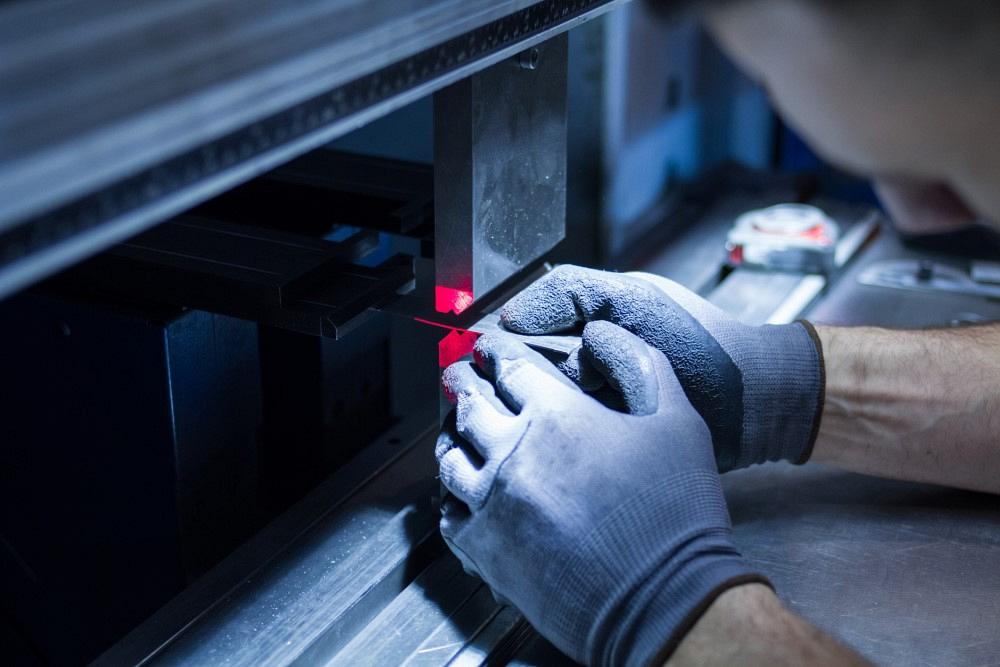- FMA
- The Fabricator
- FABTECH
- Canadian Metalworking
Categories
- Additive Manufacturing
- Aluminum Welding
- Arc Welding
- Assembly and Joining
- Automation and Robotics
- Bending and Forming
- Consumables
- Cutting and Weld Prep
- Electric Vehicles
- En Español
- Finishing
- Hydroforming
- Laser Cutting
- Laser Welding
- Machining
- Manufacturing Software
- Materials Handling
- Metals/Materials
- Oxyfuel Cutting
- Plasma Cutting
- Power Tools
- Punching and Other Holemaking
- Roll Forming
- Safety
- Sawing
- Shearing
- Shop Management
- Testing and Measuring
- Tube and Pipe Fabrication
- Tube and Pipe Production
- Waterjet Cutting
Industry Directory
Webcasts
Podcasts
FAB 40
Advertise
Subscribe
Account Login
Search
What you need to know if you're new to the press brake
Things novice operators should learn about bending metal, and why it's important to stay the course
- By Steve Benson
- November 2, 2020
- Article
- Bending and Forming

Bending guru Steve Benson writes a letter to a rookie about the challenging, sometimes frustrating, but ultimately rewarding career of the press brake operator. Getty Images
Most shops that produce sheet metal products have a press brake, and at first glance it looks straightforward. In some respects, it is. You insert tooling, and the ram goes up and down to bend parts. In reality, of course, the press brake is arguably the trade’s most difficult machine to master.
Bending is at the heart of any sheet metal operation. It requires an engineer who understands the machine and the processes it performs; a programmer who understands the nature of notching and its effect on the formed product; and, most important, an operator who knows his or her machine and its tooling.
Operators should know the press brake in front of them and its controller. They need to be comfortable with the tooling and the tonnages required to produce the part. And they need to know how to maintain the machine and keep maintenance records up to date. As craftspeople, operators need to know and understand the startup, warmup, and shutdown procedures for any machine they intend to operate.
So, You Want to Operate a Press Brake?
First, find the manual and read it. It’s one of the most important things you can do. You will learn to program the press brake controller and how to apply the functions it offers, such as dwell. You’ll discover how to adjust and correct inaccuracies in the machine and to correct those errors before producing a single part.
Remember, the most dangerous press brake operator is the one who knows only enough to make the ram go up and down. And if you think about it, this logic applies to all manufacturing equipment.
A press brake is one of the most exciting machines to operate. Even if you produced the same parts yesterday and today, it will still be different every day. You might adjust for a variation in material thickness, grain direction, and other variables, all of which you’ll learn in time.
What About Tooling?
If you ever want to be a world-class practitioner of the bending arts, you also will need to understand the tooling and the reasons that you are selecting a particular punch and die.
Improper tooling selection is one of the leading causes of errors at the press brake. Like press brakes, tools are rated to handle only so much forming tonnage, and too much tonnage can damage or destroy a tool. Excessive tonnage also creates safety hazards, both for you and those working near you. A tonnage load that’s high enough can even damage or destroy the press brake itself. Selecting the wrong tool can cause you to create the wrong radius in the part, which changes the bend deduction and causes the final part to be incorrect.
The best operators know that press brake tooling is a consumable item in a production shop. Tools have a long working life, but they do wear over time. If you wish to become a world-class technician, you’ll need to know your tooling inside and out, and know the differences between a soft traditional planer tool and a hardened precision-ground tool.
Moreover, engineers and designers need to understand the tooling, its abilities, and limitations. Whether you are an operator or designing parts, you need to work with others as a team. You need to make use of available tooling while incorporating the methods of forming being employed on the shop floor. You will, no doubt, learn much from all of the different people in your shop. You’ll learn much from experience too, and there will come a time when you’ll pass on your knowledge and teach others.
Defy the prima donna brake operator stereotype. Designers and engineers aren’t fools, and neither are you. We are all just working from different branches of the same tree. We can teach each other a lot—if, that is, the information is allowed to flow.
Material Give and Take
Modern press brakes repeat their depth of penetration into the die space within microns; they repeat backgauge locations within a few thousandths. The materials you’ll bend, however, are not so precise. Everyone—including both engineers and press brake technicians—needs to understand the limitations of different materials, their tolerances, and the way they react to being bent. They also need to know how each material type is affected by the method of forming, be it air forming, bottom bending, or coining.
Mild cold-rolled steel, our baseline material, forms with less tonnage than stainless steel but more tonnage then 5052 H32 aluminum. Stainless has more springback than cold-rolled steel. Cold-rolled is anisotropic; bending angles, forming tonnage, and the floated inside bend radius can change depending on the relationship to the material’s grain direction, all of which affect results. They determine how difficult the parts will be to make.
You will have problems with parts that seem unique, even when forming a single material type and gauge. The material thickness as well as the yield and tensile strengths have tolerance ranges. No two pieces of material are precisely the same.
Sure, to say your press brake repeats in microns (a millionth of a meter) is impressive. But when the material thickness varies as much as 0.014 in., your bends can vary dramatically no matter how accurate your machine is. These variations are where your skills as an operator and technician come into play. Dealing with all these variations will make some days tough, but it also helps make operating a press brake a challenging and personally rewarding career. Forming some parts can be irritating, but the final results always are rewarding.
Blueprints and Mechanical Drawings
You’ve learned your machine and can select the right tooling. You’ve mastered the art of dealing with the material variables, and you can now adjust the process on-the-fly. And you have been making some great parts from simple CAD drawings, bending up and down at various angles and dimensions. But can you read a blueprint or a mechanical drawing?
CAD drawings default to calling all dimensions to three decimal places. A three-place callout implies the tightest tolerancing, often as tight as ±0.010 in. or even sometimes ±0.005 in. Does it need to be that close? Or are you overbuilding the part? Many dimensional tolerances on a part can be as much as ±0.020 in., ±0.030 in., or more.
Does the blueprint show a first- or third-angle projection? Is the first bend up or down? Are the tolerances dimensioned from a baseline or are they cumulative? Cumulative tolerances are called flange by flange and total up. If it’s a baseline callout, tolerancing is a direct value. That’s because all features are located relative to a single baseline feature, like the part edge.
What about the revision level? Is it Revision F instead of Revision E? The required part is not necessarily the latest version of the part, and this kind of information is not found on a typical CAD drawing. Nonetheless, it will be on the blueprint or mechanical drawing, or in the work jacket.
Learning to read blueprints and mechanical drawings is a subject unto itself. And you new folks entering the trade are at a bit of a disadvantage because high schools no longer teach this stuff. The good news is that local community colleges do. There are plenty of great books available out there for you to learn from as well, many of which can be found for only a few dollars at used bookstores.
Sure, many topics are best learned in the classroom. For instance, geometric dimensioning and tolerancing can be valuable for anyone looking for a career in the bending department, and a few books can give you a good start, but you’ll get a lot more from a great instructor.
Stay the Course
You’ll learn many more things on the way to becoming a world-class operator and technician, far too many to list in a single column. I have been in the trade for more than 45 years as an operator, programmer, engineer, author, and columnist—and you know what? I still learn new things every day. The more you learn about this or any subject, the deeper the rabbit hole gets. The more you know, the more you know how much you don’t know. And that should inspire you to seek out even more.
You have entered into an exciting career with a bright future. Some of you, of course, will move on for one reason or another. But for those of you who stay, you will be well rewarded in many ways.
To all those folks who dislike running a press brake, that’s OK. It’s not a career for everyone, nor should it be. Some who should operate a press brake will not. Others want to but shouldn’t. Then there are those of us who belong here and want to be here. To this last group, remember this as you learn the trade: It is worth staying the course. Don’t let day-to-day irritations make you give up. Stick with it. You’ll be glad you did.
About the Author

Steve Benson
2952 Doaks Ferry Road N.W.
Salem, OR 97301-4468
503-399-7514
Related Companies
subscribe now

The Fabricator is North America's leading magazine for the metal forming and fabricating industry. The magazine delivers the news, technical articles, and case histories that enable fabricators to do their jobs more efficiently. The Fabricator has served the industry since 1970.
start your free subscription- Stay connected from anywhere

Easily access valuable industry resources now with full access to the digital edition of The Fabricator.

Easily access valuable industry resources now with full access to the digital edition of The Welder.

Easily access valuable industry resources now with full access to the digital edition of The Tube and Pipe Journal.
- Podcasting
- Podcast:
- The Fabricator Podcast
- Published:
- 04/30/2024
- Running Time:
- 53:00
Seth Feldman of Iowa-based Wertzbaugher Services joins The Fabricator Podcast to offer his take as a Gen Zer...
- Industry Events
Pipe and Tube Conference
- May 21 - 22, 2024
- Omaha, NE
World-Class Roll Forming Workshop
- June 5 - 6, 2024
- Louisville, KY
Advanced Laser Application Workshop
- June 25 - 27, 2024
- Novi, MI
Precision Press Brake Certificate Course
- July 31 - August 1, 2024
- Elgin,































